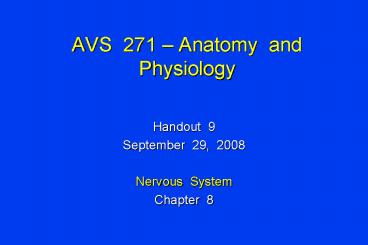AVS 271 Anatomy and Physiology
1 / 17
Title: AVS 271 Anatomy and Physiology
1
AVS 271 Anatomy and Physiology
- Handout 9
- September 29, 2008
- Nervous System
- Chapter 8
2
Resting Membrane Potential
- Transient changes in the membrane potential
from its resting level produce electric
signals - The most important way neurons process and
transmit information - Two forms of electric signals
- Graded potentials
- Action potentials
3
Terminology Changes in Membrane Potential
- Depolarize
- Overshoot
- Repolarize
- Hyperpolarize
4
Graded Potential
- Changes in membrane potential confined to a
relatively small region of the plasma
membrane - Die out within 1 to 2 mm of their
site of origin - Usually produced by some specific change in
the cells environment acting on a
specialized region of the plasma membrane - The magnitude of the potential change can
vary (i.e., is graded) - All cells can develop a graded membrane
potential - Function at afferent nerve receptors,
synapses, and other specialized areas - May increase or decrease the likelihood of
an action pot.
5
Action Potential
- Rapid (1 msec), large alterations in the
membrane potential - e.g., change from -70 mV to 30 mV
- Only occur in excitable membranes
- Nerve, muscle, some specialized cells
- Propagation of action potentials is the
mechanism used by the nervous system to
communicate over long distances
6
Action Potential
- Result from a transient change in membrane
permeability, which allows selected ions to
move down their concentration gradient - In the resting state, primarily potassium
channels are open - resting membrane potential of -70 mV
- The depolarizing phase of an action
potential is due to the opening of voltage
gated sodium channels - The repolarizing phase is due to the
opening of voltage gated potassium channels
7
Action Potential
8
Positive Feedback Cycle
Generally starts with a localized graded
potential
9
Threshold Potential
- Not all membrane depolarizations trigger the
positive feedback cycle that leads to an
action potential - The positive feedback cycle starts once
sodium influx exceeds potassium efflux - i.e., the net movement of positive charge
is inward - The membrane potential at which this occurs
is the threshold potential - Approximately 15 mV less negative than the
resting membrane potential for most
excitable membranes
10
All or None Response
- Action potentials either occur maximally or
they do not occur at all - If a stimulus causes the membrane to reach
the threshold potential, an action
potential will occur - If a stimulus does not cause the membrane
to reach the threshold potential, an action
potential will not occur - Because they are all or none, an action
potential cannot convey information about
the magnitude of the stimulus that
initiated it
11
Threshold and The All or None Response
12
Refractory Periods
- Absolute refractory period
- Relative refractory period
- Play a key role in determining the
direction of action potential propagation
13
Absolute Refractory Period
- During an action potential, a second
stimulus, no matter how strong, will not
produce a second action potential - Voltage gated sodium channels enter a
closed, inactive state at the peak of the
action potential
14
Relative Refractory Period
- After the absolute refractory period, there
is an interval during which a second
action potential can be produced, but only
if the stimulus strength is greater than
usual - Continued inactivation of sodium channels
- Excess potassium channels are open
- Membrane is hyperpolarized
15
Action Potential Propagation
16
Action Potential (movie)
17
(No Transcript)































